WA CITRUS pest management
PEST
MANAGEMENT
in lemon orchards
In south west Western Australia, lemon trees flower and fruit throughout the year. Trees normally flower heavily in spring followed by intermittent lighter flowerings during summer and into autumn. The main crop matures in winter, but several smaller crops mature from spring to autumn.
Words Rachelle Johnstone, DPIRD Research Scientist
HIS continuous crop cycle can lead to a greater number of pests and pest generations in a single year than in other citrus crops such as oranges and mandarins that only have winter flowering. In addition, with flowers and fruit being present on the tree at the same time, growers need to be conscious of the withholding period of any pesticide to be used before harvest, as well as potential maximum residue levels (MRLs) to be considered if exporting.
The Citrus Integrated Pest and Disease Management (IPDM) extension project team established two demonstration sites in the south west of WA (Harvey) to investigate the level of pests and beneficials in lemon orchards. Rachelle Johnstone, Department of Primary Industries and Regional Development Research Scientist and Bronwyn Walsh, WA Citrus Industry Development manager, monitored the sites weekly to fortnightly to guide pest management decisions.
Orchard monitoring
Learning to recognise pests and beneficials and understanding their lifecycles and seasonal trends with regular orchard monitoring is a key component of IPDM. To be effective, it must be done regularly and systematically.
When starting a monitoring program, create a recording sheet for field recording and a spreadsheet for entering data to track numbers over time and between years. A 10X hand lens is useful for getting the right identification and when unsure, collect specimens or take photos for identification by an entomologist or crop scout. For more information on IPDM and monitoring see the What is IPDM? factsheet produced by the project team.
The two Eureka seedless lemon orchard sites were monitored regularly since September 2024. At each monitoring event, 15 trees were randomly sampled at both sites and presence or absence of pests and natural enemies (beneficials) were recorded to determine the percentage of samples infested.
The infestation level helps determine if management actions are required. Action levels are the point at which an economic loss can occur if no action is taken.
Main pests found`
Kelly’s citrus thrips, lemon bud moth and mealybugs were found most frequently and in a higher number of samples. Low numbers of crusader bugs, red scale, brown scale and cottony cushion scale were also found less frequently. Even though pests were found in the orchard, the percentage of samples infested rarely exceeded the action levels.

Kelly’s citrus thrips damage is recognisable as a ring or ‘halo’ around the calyx.
Thrips
While several species of thrips are found in citrus, Kelly’s citrus thrips (KCT) and Greenhouse thrips can cause economic damage. Feeding damage to fruit is recognisable as a ring or ‘halo’ of brownish tissue at the stem end, or as russet or grey scarring between touching fruit. Wind damage can often be confused as thrips damage. Accurate identification of thrips and damage is important to avoid unnecessary spraying.
Kelly’s Citrus Thrips were found at both sites, mainly adults in flowers from September to early December. KCT damage is caused mostly by larvae during the first 4–5 weeks after petal fall (mid-October to mid–late November). The presence of adult KCT in flowers will give an indication of a potential risk of infestation but does not indicate the presence of larvae. To find KCT larvae, look between the fruitlet and calyx. Larvae are pale yellow to bright orange and up to 2 mm long. It is difficult to tell the difference between KCT larvae and the larvae of non-damaging thrips without a microscope. Action is required if more than 5% of fruit samples are infested with larvae. Adults are black, 2 to 3 mm long, with black legs and dark parallel wings with a small clear band at the top.
Lemon bud moth
Lemon bud moth larvae, adults and damage was observed at both sites, peaking in mid-December to mid-January. Adult moths lay eggs on developing flower buds, hatched larvae then bore into the buds, feeding on the internal parts and ovary. Damage to flowers and developing fruit from larvae can reduce fruit set or cause misshapen fruit. It is not usually an economic problem in the main crop but can be threat to fruit set from late summer to early winter.
Damaged flowers can be identified by a small hole in the developing flower bud. Unfortunately, very little research has been done on this pest in Australia. The action level is 50% or more flower terminals or shoots infested, however there are currently no registered chemicals for lemon bud moth in citrus.
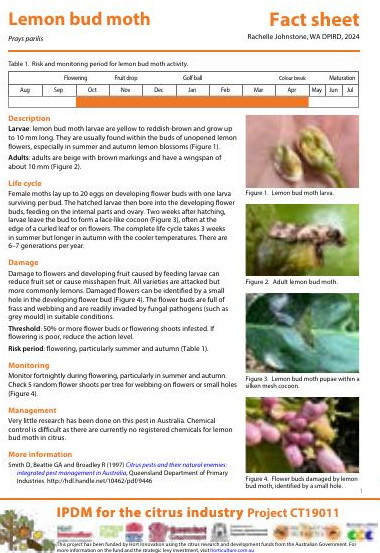
Lemon bud moth factsheet: www.dpi.nsw.gov.au/__data/assets/pdf_file/0004/1602778/Lemonbud-moth.pdf
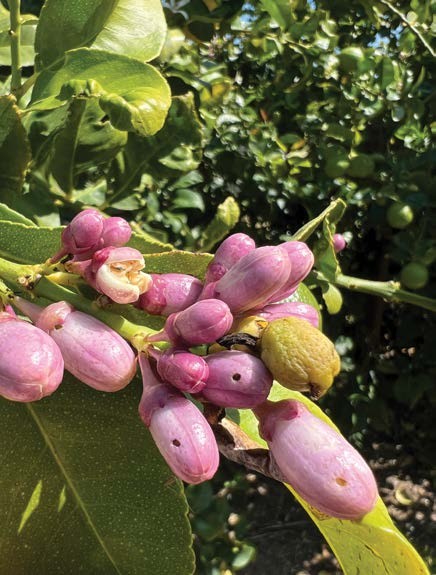
Lemon bud moth damage can be identified by a small hole in the developing flower bud.
Mealybugs
Mealybugs were found from September to early December in high numbers at Site 1 but below the threshold at Site 2. Mealybugs feed on sap and excrete honeydew, which encourages the growth of sooty mould and other fungi. To find mealybugs when monitoring, a 10X hand lens should be used to examine under the calyx.
Natural enemies
Natural enemies are the parasitoids, predators, and pathogens that attack pests. The reduction of pests by natural enemies is known as biological control. Natural enemies are often referred to as ‘beneficials’ and are extremely important for pest management in citrus.
Beneficials were observed at both sites, with numbers increasing in late October, peaking in mid-Nov to early December.
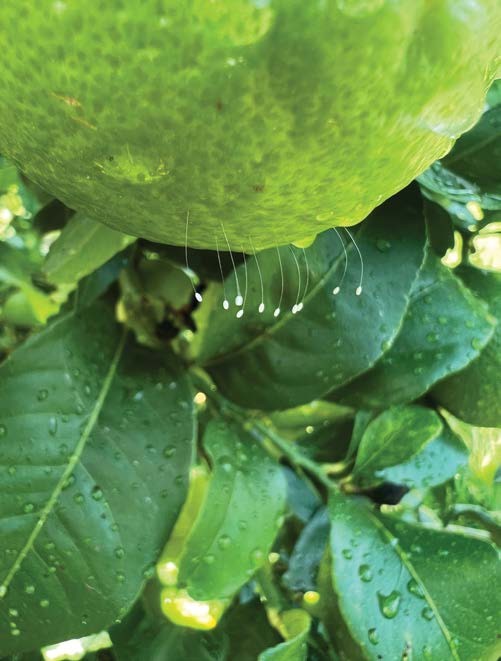
Green lacewing eggs attached to citrus fruit by long, flexible stalks.
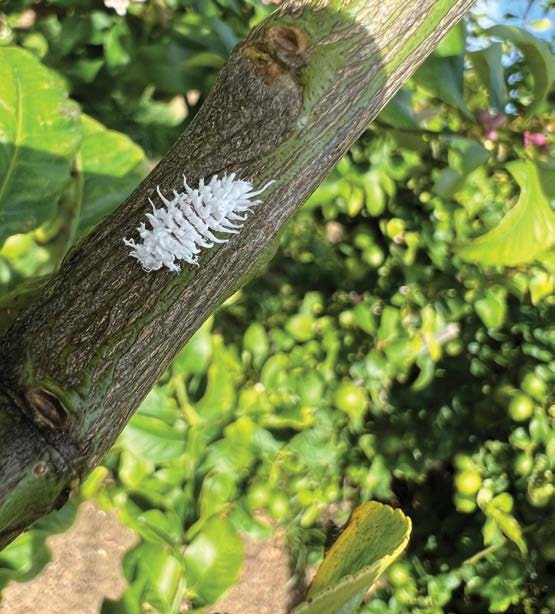
Cryptolaemus montrouzieri (mealybug destroyer) larvae are active predators of mealybugs and soft scales.
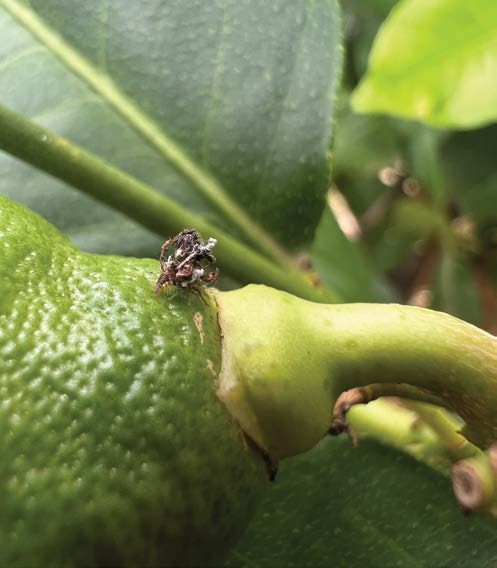
Green lacewing larvae are active predators in citrus orchards, they disguise themselves with the exoskeleton of their prey and plant debris.
The main beneficials observed were green lacewings, Cryptolaemus montrouzieri or ‘mealybug destroyer’, lady beetles, jumping spiders and parasitic wasps.
Green lacewing eggs were the most commonly observed beneficials at both sites. The eggs are white and attached to the underside of leaves by long, flexible stalks. They are usually found in groups but were observed singularly on leaves, stems and fruit. Green lacewing larvae are active predators in citrus orchards, they disguise themselves with the exoskeleton of their prey and plant debris. They prey on aphids, moth eggs, small larvae and scales.
Boosting beneficials
Natural enemies can be encouraged in the orchard using various cultural practices. When possible, use a pesticide that is least disruptive to natural enemies. If they must be used, selectively spray problem areas. Predatory mite populations can be encouraged by improving their natural habitat —building up soil organic matter and maintaining grasses (alternate inter-row slashing).
Key learnings
• Lemons are more susceptible to pests like Kelly’s citrus thrips and lemon bud moth due to the continuous flowering over the year.
• Not everything that moves in the orchard is a pest.
• Just because a pest is there, doesn’t mean there’s enough to cause economic damage.
• Chemicals and natural enemies can be part of managing pests in citrus.
• Regular montitoring provides confidence to ‘wait’ another week, or make the decision to act
• There’s a bit to digest, but there are people and information to help.
• It’s great to see birds, spiders and beneficials in the orchard, perhaps some indication that the ecosystem is not too bad.
MORE INFORMATION
Individual IPDM pest fact sheets, posters and webinars can be found on the Citrus IPDM extension program webpage (https://www.dpi.nsw.gov.au/agriculture/horticulture/citrus/content/ipdm-extension-program).
The Citrus IPDM extension project has been funded by Hort Innovation, using the citrus research and development levy and contributions from the Australian Government. Hort Innovation is the grower-owned, not-for-profit research and development corporation for Australian horticulture.
Rachelle Johnstone, rachelle.johnstone@dpird.wa.gov.au, 9780 6158.